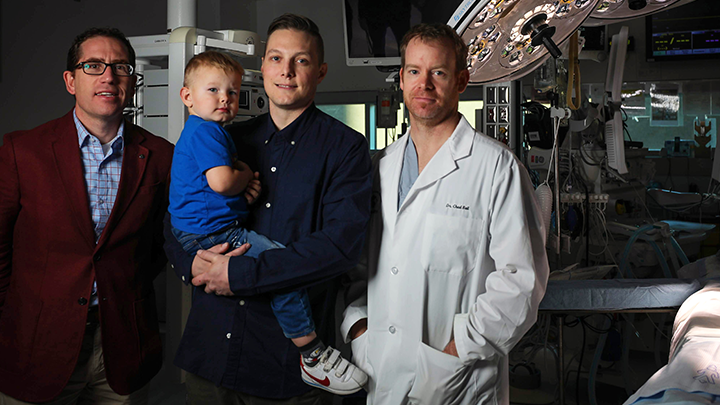
November 19, 2019

Mike Meldrum, President and CEO of the Calgary Health Trust, left, patient Kolton Dushanek and his son Pryce, and trauma surgeon and researcher Dr. Chad Ball, share a moment in the Interventional Trauma Operating Room where Kolton underwent life-saving surgery.
Story by Greg Harris | Photo by Leah Hennel
CALGARY — No one has to persuade Sylvan Lake resident Kolton Dushanek of the value of the Interventional Trauma Operating Room (ITOR) at Foothills Medical Centre.
In April this year, the 30-year-old wound up in the specialized surgical suite with two critical injuries after he lost control of his motorcycle on loose gravel.
Either of those injuries — a torn aorta, which is the vessel that carries blood from the heart, or a shredded liver — could have been fatal. But because of ITOR’s technological capabilities, teams of surgeons were able to repair both injuries at the same time, in the same location.
“I think if I would have had this accident anywhere else, I don’t know if I would have survived,” Dushanek says. “Obviously I’m super-thankful for it. What a great thing to have in Calgary.”
New research shows that about 80 people like Kolton owe their lives to the existence of the ITOR, which opened more than six years ago at Foothills Medical Centre.
Funded by the Calgary Health Trust and Alberta government, the $6-million facility brings together in one suite the capacity for traditional surgery, diagnostic imaging and angiography, a technique that enables surgeons to make repairs via blood vessels.
“Not to sound dramatic, but Kolton would not be alive if not for this room,” says Dr. Chad Ball, a trauma surgeon and senior author of a paper that compares patient outcomes before and after the facility opened — which is also known as RAPTOR, short for Resuscitation with Angiography, Percutaneous Techniques and Operative Repair.
“He had two dominant, competing problems: his liver smash and a torn thoracic aorta. Both of those had to be fixed in the same location at the same time.”
For Kolton that meant one surgical team was able to perform a traditional open surgery to work on his liver, while another used angiography and specialized catheters to work on his aorta.
Hospitals have in the past created separate spaces for traditional surgery, angiography and diagnostic imaging — meaning that without a facility like ITOR, trauma surgeons dealing with multiple injuries have had to choose which to tackle first — while the clock is ticking.
Dr. Ball says the standard death rate for severely injured patients arriving at trauma centres with ongoing bleeding is about 50 per cent, or like flipping a coin.
“With the use of the ITOR, the death rate has gone down to 16 per cent. That may not sound like a lot, but the order of magnitude in terms of change is really historic in terms of benefit,” he says. The improvement benefits roughly one per cent of trauma patients — the equivalent of saving one additional life a month.
Mike Meldrum, president and CEO of the Calgary Health Trust, says the foundation’s investment in ITOR has been a great success story.
“It’s impressive, just the number of lives that have been saved — how do you put a price on a life?”
“This really is a beautiful example of the partnership between donors and the health system,” Meldrum adds. “Donors really get out of it the satisfaction of knowing they’re innovating the health system, and healthcare providers get the opportunity to work on exceptional technology and equipment … and it has a lasting impact on the community.”
The ITOR was one of the first facilities of its kind anywhere in the world when it first opened in March 2013, and it remains the only hybrid OR in the province dedicated to trauma. There’s also a hybrid OR at the Mazankowski Alberta Heart Institute in Edmonton, however it is not used for trauma.
Since the hybrid OR at Foothills opened, the Calgary Health Trust has funded hybrid ORs at both FMC (for cardiac surgery) and Peter Lougheed Centre (for vascular surgery).
Today, Dushanek is working at getting back some of the strength he lost after spending close to 40 days in the Intensive Care Unit and another 30 days in hospital —a period that included multiple surgeries.
“I think I was hooked up to just about every machine they have,” he says. “Everything they were able to do for me there was just incredible … they really go the extra step to take care of you.”
He and his wife and two young children temporarily relocated to Calgary for his recovery, but are currently planning a move back to Sylvan Lake.